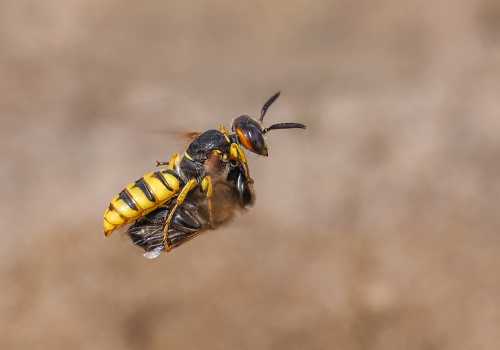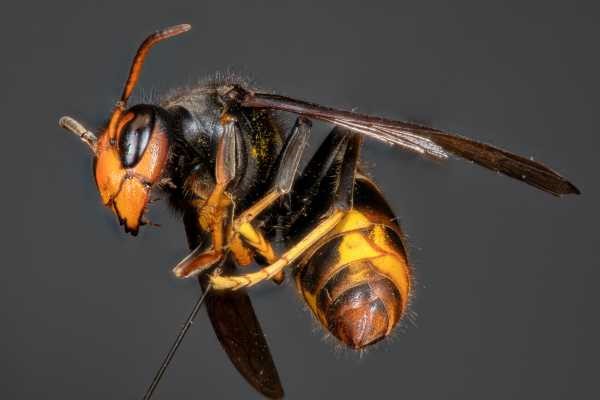Bee Hive Vs Wasp Nest
Are you wondering whether you have a bee hive (nest) or wasp nest on your property? Or perhaps you are curious to understand the difference between bee hives and wasp nests?
Bees and wasps are related, and there is huge variety between species. Bees and wasps both have groups of species that can be solitary, primitively social or social.
Some bee and wasp species nest in the ground, others in cavities or aerial nest (self constructed or otherwise), and construction materials can vary greatly. Other bee and wasp species are cuckoos or parasites, and don't create their own nests at all.
Bee Hive Vs Wasp Nest
Bee hives and wasp nests are both fascinating structures, and equally merit our awe for their architectural precision and beauty.
How the nests of honey bees and social wasps are similar, and different
Here, we'll look specifically at the differences and similarities between a honey bee hive (or nest) of the bee family Apidae, and nests of social wasps, of the wasp family Vespidae.
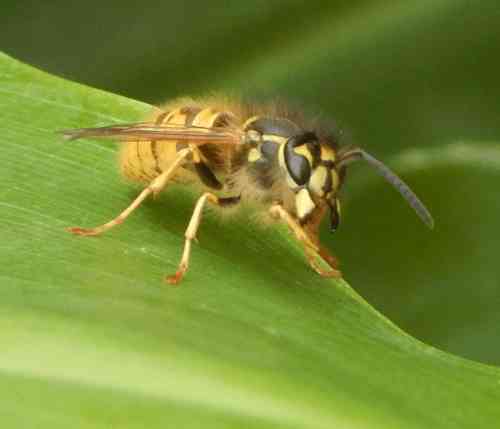 Vespula wasp
Vespula wasp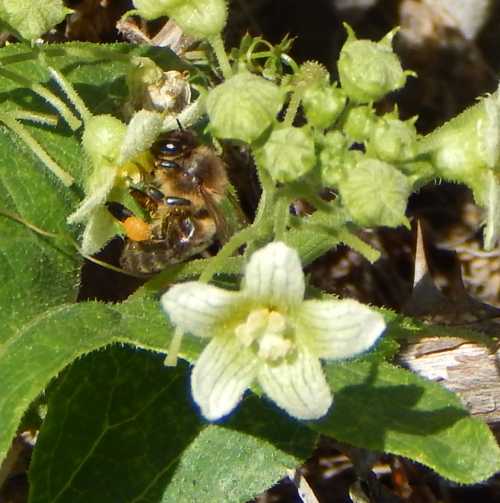 Honey bee
Honey beeBefore we go on, it's worth noting that the term 'bee hive' and 'nest' seem to be used interchangeably, but honey bees may raise colonies in natural nests, the like of which are found in hollow tree trunks or other large cavities, as well as caves. Alternatively, they may raise a colony in a man made, wooden structure, which I actually prefer to call a 'bee hive'.
For the purposes of this page, for honey bees, it's equally valid to refer to both man-made structures (bee hives) and wild honey bee nests, in a comparison with social wasp nests.
Use of hexagons in bee hive and wasp nest
Where social wasps and honey bee nests are similar, is in their use of hexagon shaped cells where both sets of species raise their offspring.
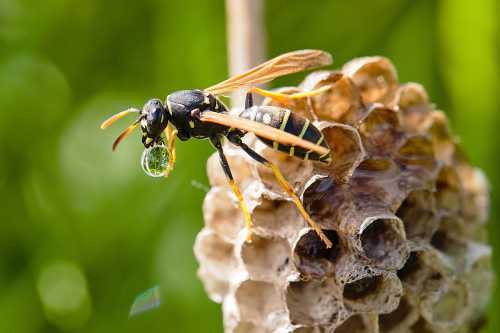 Paper wasp nest cells
Paper wasp nest cellsMaterials for nest cell/comb construction
However, despite the similar use of hexagons, the materials used are quite different.
Honey bees use beeswax which young honey bees themselves create from inside their abdomens. In contrast, wasps construct their nests from plant matter, often tiny slithers of masticated wood which they collect from around them.
In the short videos below, you can watch first a queen wasp starting off her nest using pulp, and below that, a young honey bee worker removing a scale of wax from the underside of her abdomen for creating a wax cell.
(Video of wasp supplied by Kathleen, Co Antrim, N. Ireland)
Nest locations
For honey bees, their nests are created in pre-made caverns in tree hollows, unused chimneys, caves, or the space provided by a bee hive, and nests are generally above ground.
Some social wasp species also make use of pre-existing cavities, but aerial nesters, such as Polistes (the paper wasp) and Dolichovespula, create their own exposed hanging structures.
Some social wasp species, particularly Vespula species, will also construct aerial nests or make use of underground rodent burrows.
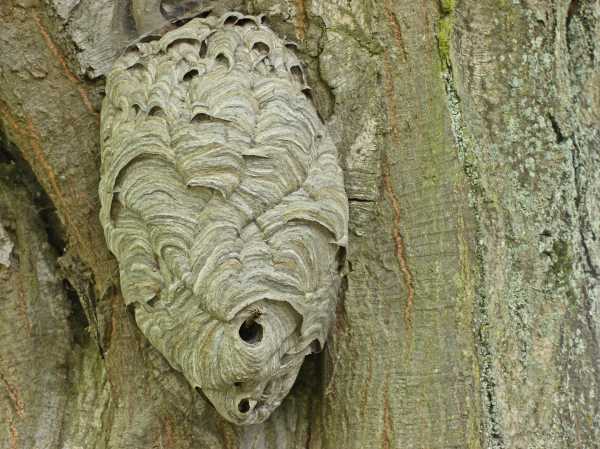 Nest of a Median wasp Dolichovespula media on a tree
Nest of a Median wasp Dolichovespula media on a tree
Perennial nests
Honey bee nests, provided they remain healthy and safe from disease and predators, are perennial, meaning they can last multiple years.
At the time of writing this article, I have been observing a wild honey bee nest in a tree trunk for 4 years, though it may be older. (See; Do honey bees forage in cool temperatures).
Some social wasp nests last only a season, and the whole colony dies by winter time, with only the queens or dominant females (gynes) surviving.
The nests of other social wasps (especially tropical species) are perennial, one such example being the nest of the honey wasp (Brachygastra species) found in South America.
Swarming and new nests
New honey bee nests or hives are started by swarming. Part of the former colony remains with a new queen at the founding nest or hive, whilst the rest, along with the old queen swarm to find a new nest site.
In some social wasp species, each year, nests are founded by newly emerged queens or gynes that have thus far been overwintering in a sheltered spot until spring.
However, other species (notably in tropical regions) engage in swarming, in fact one study details 30 species from the subfamily Polistinae, which engage in swarming. Furthermore, species of swarming wasps communicate new sites with chemical trails.
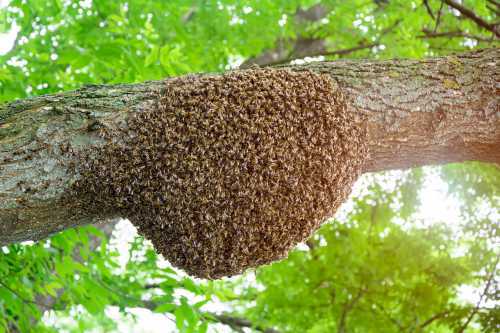 Honey bee swarm
Honey bee swarmFood storage at the nest
Some of the hexagonal cells in the nests of honey bees contain nectar to convert into honey (honeycomb). Honey is food stored for the bees to eat during winter, and when foraging conditions are challenging.
In contrast, because nests of most well-known social wasp species will only last a season, you won't find any food stores in the nest. Adult wasps feed primarily on nectar, sometimes arthropods, which are also fed to their larvae.
However, again, there are exceptions. For example, honey wasps have a perennial nest. The colony stores honey for food during times of limited foraging opportunity. See Do wasps make honey?
A queen or gyne in the nest, and colony hierarchy
Another similarity between honey bee nests and for some social wasp nests, is the colony hierarchy, consisting of a queen or gyne, a mass of workers and drones/males.
On the other hand, the colonies of wasps in the subfamily Polistinae have no distinct caste system. Instead, many females lay eggs, tolerating each other, and these egg layers are tested and regulated in some manner by the sterile workers. (It is interesting to compare this tolerance of multiple egg-layers, with that observed in honey bee colonies with egg-laying workers).
There are further differences. Whilst in honey bee nests, there is (usually) a single queen, her primary roles are laying eggs, mating, and communication to help keep the colony running as an efficient superorganism.
The honey bee queen does not, however, get involved with building hexagonal wax cells (combs), even during the founding of a new nest. The hexagonal cells are built by worker bees.
In contrast, new wasp nests are specifically started by wasp queens or gynes, who meticulously engage in gathering nest making materials, chewing it to a pulp, then forming the first of the cells.
Only after several adult worker wasps are fully reared, do queen (or gyne) wasps retire from nest building to focus only on egg laying, whilst workers continue with nest construction.
Nest size
Nest and colony size can vary massively.
In general, honey bee colonies can reach 50,000 to 60,000 bees, but colonies can be larger or smaller.
In 2014, a bee hive measuring 20 feet high and holding an estimated 200,000 to 500,000 bees (you read that correctly!), had to be removed by experienced specialists, from inside the a wall cavity of a home in Texas!
According to the Guiness Book Of Records, the world's largest wasp nest was found in New Zealand in 1963. There were no estimations for the number of wasps inside, but the nest measured 12 ft 2 in tall with a circumference of approximately 18 ft. Nevertheless, various web resources report huge wasp nests containing an estimated 100,000 wasps.
One scientific paper notes the huge size of the wasp nests of the species Agelaia vicina, with one nest described as consisting of more than 7.5 million cells, and one colony estimated to have over 1 million adult wasps, with 482,668 adults actually collected.
Bee hive vs wasp nest comparison table
| Honey Bee Hive Or Nest | Social Wasp Nest | |
|---|---|---|
| Nest comb construction materials | Beeswax made by bees | Plant matter (wood pulp) |
| Nest cell shape | Hexagon | Hexagon |
| Longevity | Perennial | Annual or perennial |
| New nest formation | Swarming | Single new queen / gyne or swarming in some species |
| Nest cell purpose | Raising offspring, storing food | Raising off spring. Some species store food. |
| Locations | Cavitities (man-made or natural) | Cavities, exposed aerial locations or underground |
| Social hierarchy | Queen, workers and drones | Queen or gyne, or fertile and sterile females and males |
| Nest size | Variable (thousands) | Variable (hundreds to thousands) |
Resources
- Eaton, E. R. Wasps - The Astonishing Diversity Of A Misunderstood Insect. Princeton University Press 2021.
- NOLL, FERNANDO B., and JOHN W. WENZEL. “Caste in the Swarming Wasps: ‘Queenless’ Societies in Highly Social Insects.” Biological Journal of the Linnean Society 93.3 (2008): 509–522. Web.
- Britain's Insects - A Field Guide To The Insects Of Great Britain And Ireland by Paul D Brock.
- See further links to further information on this site.
- 'At 2 stories and 500,000 bees, hive discovered in Spring home shocks experts' - chron.com.
- www.guinnessworldrecords.com/
- Jeanne RL. 1991. The swarm-founding Polistinae. In: Ross KG, Matthews RW, eds. The social biology of wasps. Ithaca: Cornell University Press, 191–231
If you found this page helpful or interesting, I'd really be grateful if you would share it with others - if not this page, perhaps another, such as Gardening For Bees.
Thank you so much :) .
